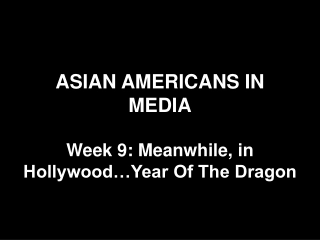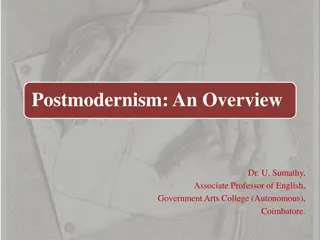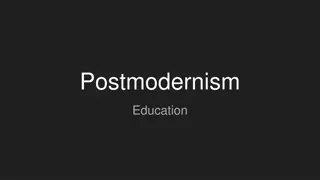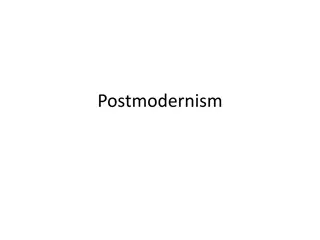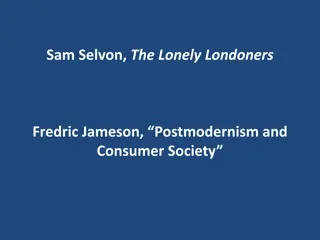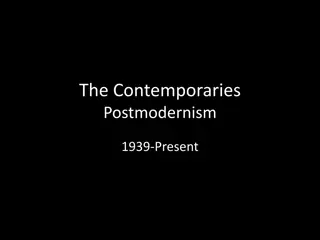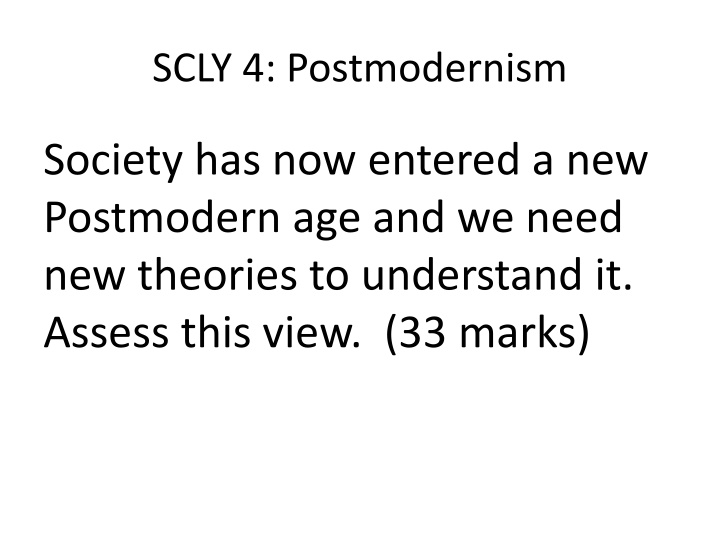
Understanding the Shift to Postmodernity in Society
Explore the transition from modernity to postmodernity, examining key features of each era such as industrialization, media saturation, and changes in social identity. Scholars like Baudrillard and Bauman provide insights into the challenges and complexities of the postmodern age.
Download Presentation

Please find below an Image/Link to download the presentation.
The content on the website is provided AS IS for your information and personal use only. It may not be sold, licensed, or shared on other websites without obtaining consent from the author. If you encounter any issues during the download, it is possible that the publisher has removed the file from their server.
You are allowed to download the files provided on this website for personal or commercial use, subject to the condition that they are used lawfully. All files are the property of their respective owners.
The content on the website is provided AS IS for your information and personal use only. It may not be sold, licensed, or shared on other websites without obtaining consent from the author.
E N D
Presentation Transcript
SCLY 4: Postmodernism Society has now entered a new Postmodern age and we need new theories to understand it. Assess this view. (33 marks)
Modern Society (since the 18thcentury) Modern society first emerged in the late 18th century and is often subtitled the enlightenment The key focus has been on how enlightened we have become with the advance of science, rational thought and reason. We became enlightened as we threw off the shackles of religion, customs and ascribed status. Links with other units???
Key features of modernity: The Nation state: a bounded territory controlled by a centralized government whose people share language and culture. Capitalism: Most modern societies have capitalist bases largely privately owned means of production. But wealth distribution is unequal leading to conflict. Science and technology: science dominates as secularism replaces religion rational thought and new technology push this forward. Individualism: Customs and traditions become less important as we gain greater personal freedom.
How is Postmodernity different to Modernity? MODERNITY Industrialisation and production POSTMODERNIST Service based industries Consumption, the media and lifestyles become the major sources of identity Work and social-class as the main forms of social division and social identity Pic n mix too many products to choose from Clear distinctions between high and low/pop culture Politics focuses on personal issues and concerns (religious, sexuality, environment) Politics centres on class differences Globalisation has replaced nation states boundaries are blurred. Multinational companies replace/dictate national identities Nation-states and national identities are dominant
Baudrillard (2001) Postmodern era is so dominated by media imagery that it has become media-saturated The mass media used to reflect some basic reality of the world, but media images now dominate and distort the way we see the world. Baudrillard suggests that the media present, what he calls, simulacra images that appear to reflect real events, but that actually have no basis in reality. He calls this distorted view of the world hyperreality. It is the view created and defined by the media.
Bauman (1996) Bauman argues that postmodern life resembles a shopping mall. People stroll around, buying what they like, trying out a range of identities and changing them when they choose - A pick and mix culture. The former influences of gender, ethnicity, class and even age no longer apply people are not constrained by them like they were in the past.
Giddens: Doesnt really like the term Postmodernity He prefers Late Modernity Theories in this section believe that changes are occurring but that they are a continuation of modernism rather than a completely new thing. Giddens Reflexivity: We are now in a stage of high modernity where rapid change is having a global effect.
Giddens Reflexivity: Disembedding: We no longer need face to face interaction and therefore it is much more impersonal e.g. email, eBay etc. In 2005, 1/8 of couples that married that year met on the internet Reflexive: Traditions and customs are less important and we are forced to reflect on who we are, what we are etc. No jobs for life anymore, geographical mobility takes us away from our roots etc.
Beck Risk Society He sees modern society as facing dangers; In the past most dangers were natural earthquakes, disease, drought. Today more dangers are manufactured risks resulting from human activity global warming, pollution etc He agrees with Giddens about the growth of individualism and says we constantly need to reflect on our actions (he calls it reflexive modernisation). As a result awareness of risk becomes central to our lives what we eat, where we go, what our children are doing etc
Some Marxists criticise Pomo Philo and Miller (2001) Theories like Baudrillard s hyperreality and simulacra claim that media images are unconnected with reality. They ignore how the ruling classes use these as an ideological tool of domination. If we construct out identities through consumerism what about those that suffer poverty? Pomo s claim that people cannot distinguish between media image and reality.
Pomo is non-judgemental all views are valid (even Fascism?) Lyotard says there are no universal truths anymore why should we believe a theory that claims that no theory holds the truth? Best and Kellner (1991): Pomo holds value in that it identifies key features of today s society (consumption, the media).. But it doesn t explain how this came about
Postmodernism has identified some important features of society put it is poorly equipped to explain them. Late-modernity theories (Giddens, Beck) have been more successful in offering explanations for the changes that society is undergoing.
Postmodernists like Baudrillard believe that there is no way of knowing if something is true or false Late modernists like Giddens and Beck disagree: Even though late modern society has many risks - we can use science and rationality to overcome them and improve society For example, new political movements like environmentalism challenged technological and industrial development.
Some Marxists criticise Late-mo Rustin (1994) Capitalism and the pursuit of profit causes risk not technology. Hirst (1993) Environmental groups are too small and fragmented to challenge capitalism and TNC s.
Agree with Postmodernists (Baudrillard, Bauman) Disagree with late modernists (Beck, Giddens) Postmodernity is the latest stage of capitalism Postmodernity rose out of the financial crises that occurred in the 1970 s.
Aids business and communication especially international as well as machine production Breaking down of geographical barriers Individualism, fragmentation and geographical mobility ICT Switching from producing one product to another Job No jobs for life anymore less To accommodate constantly changing fashions insecurity employer loyalty Flexible accumulation aka Choice Post-Fordism Loss of tradition / decline of metanarratives Cultural diversity promoted: New Niche markets markets open up Working on Sundays Flexible workforce Secularisation Diversity
Flexible accumulation also changed consumption habits Leisure, culture and identity become commodities/products Fashion, music and sport have become important sources of profit Jameson (ultra-important quote): Postmodernity represents a more developed form of capitalism because it commodifies basically all aspects of our life
Harvey argues that this developed form of capitalism has shrunk the world (compression of time and space) It has also weakened working-class/socialist movements. These have fragmented. The key strength of Marxist Postmodernism is that it identifies a cause of these recent societal changes capitalism. Postmodernism does not.

